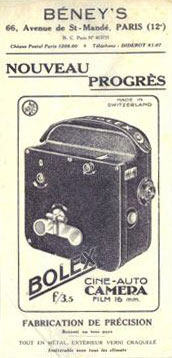
AUTO CINE A
16mm Camera
1928
- OVERALL DIMENSIONS: Approximately 6in x 6in x 2 2/5in (15cm x 15cm x 6cm)
- WEIGHT: Approximately 3.5 lbs (1.5 kg)
- OUTER CASE: Polished aluminum alloy, covered with black crinkle paint.
- FILM CAPACITY: 50 ft (15m) daylight loading spools of 16mm film.
- THREADING: Manual threading
- MOTOR: Constant speed, key wound spring motor. Winding key could be removed or simply folded back against its side when not in use.
- LENS: Fitted with a 25mm Anastigmat f/3.5, but without an interchangeable mount.
- VIEWFINDER: Built-in optical preview finder.
- PRECISE SPEED: Exposures are made at 16 frames per second.
- RELEASE BUTTON: Finger tip release allows for continuous exposures.
- SHUTTER: Speed of each exposure is 1/40th second.
- FOOTAGE COUNTER: built-in; indicates the amount of film run through the camera.
- MANUAL CRANKING: could be accomplished on later versions of this model, as well as backwinding. Two sockets on the side of the counter allowed for hand cranking at different rates; one turn progessing 8 frames or two turns progressing 1 frame.

Notes and Comments
The Auto Cine A was the first camera produced by Jacques Bogopolsky under the Bolex name. He had previously patented the Bol Cinegraph in 1924; a combination 35mm motion picture camera and projector that could film, as well as project both still and moving images.
16mm film had become an increasingly popular gauge among amateurs since its introduction by Kodak in 1923. In 1928, Bogopolsky introduced the Bolex Auto Cine which accepted 50ft daylight loading spools of 16mm film.
Two versions were available: the original is seen on the brochure at the right; the later model, seen in the illustration at the very top of this page, was modified to include a manual drive shaft for hand cranking and rewinding film. Both versions appear to have been fitted with a 25mm f/3.5 Anastigmat lens, although I'm unsure of the manufacturer.